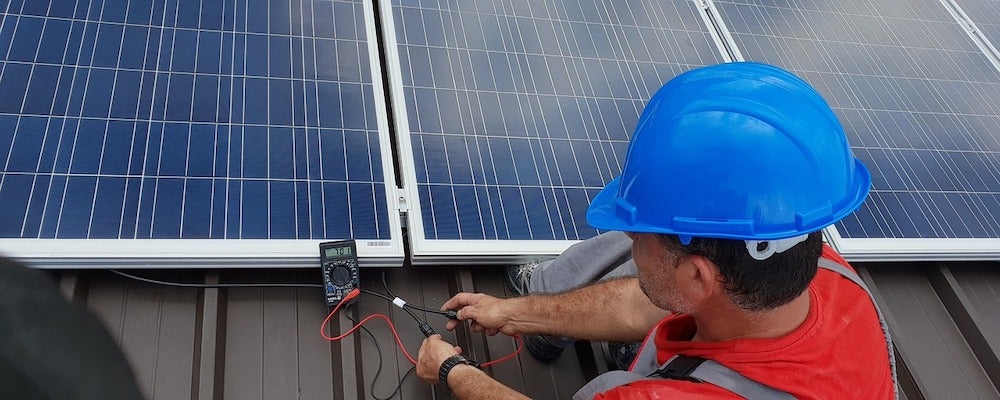
One of the first questions homeowners have when they’re thinking about installing home solar panels is “how long will the installation take?”. Believe it or not, the actual installation can take as little as six hours. But, going solar consists of a lot more than just getting contractors up on your roof. There are a few additional factors you need to keep in mind when trying to plan out how and when to complete your installation.
We’ll walk you through the solar installation process and determine how long it may take for your home.
Solar installation timeline at a glance
- The total solar installation process will take somewhere between two and six months to complete.
- Typically, contractors install a residential solar system in as little as 6 hours.
- The longest part of the installation process is waiting for permit approval, which has the potential to take almost two months to complete.
- Once the system is installed, you still need to wait for one to six weeks for your city and utility to inspect and approve the installation.
- Waiting for the installation to be complete is worth the investment, as the system will provide you with thousands of dollars in electrical bill savings over 25 years.
Solar panel installation process timeline
Installation is just one piece of the puzzle when it comes to switching to solar. Eight key steps make the entire process last anywhere from two to six months on average.
1. Choosing a solar installer
Time: 1 day to 2 weeks
Choosing a solar installer is the first and most important step of your entire solar journey. What company you pick determines not only the price of your installation but the quality and timeline as well!
You want to make sure you’re picking a reliable company that’s been in business for at least 5 years, have a NABCEP certified installer, and has positive customer reviews. This step can take you just a few hours, but it’s important to take the time to not only find a few installers you like, but also get and compare quotes from them. You definitely don’t want to cut corners when it comes to choosing the right company.
Getting at least three quotes will increase your chances of getting the highest quality installation at the best price point. The easiest way to find trustworthy solar companies in your area is by using our state-of-the-art solar calculator, which lets you see your potential solar savings and can help you start collecting quotes.
2. Site assessment
Time: 1 week
After you choose your solar installer, they’ll need to perform a site assessment to make sure your roof is suitable for a solar installation. Someone from the installation company will come out to your house and take a look around to check out the condition, shading, size, and direction of your roof. They’ll also make sure your roof can handle the weight of solar panels, and take a look at your electrical panel to see if it would need any upgrades.
The site assessment will take less than a day, just a few hours at most, but we give this a timeframe of about one week to take scheduling into account.
3. System design
Time: 2 to 3 weeks
Once it’s determined that your roof is ready for solar, an engineer will get started on designing your solar system. Your electricity usage, roof characteristics, local building code requirements, and utility requirements are all taken into account when designing the system.
The design process can take anywhere from two to three weeks on average, but it may take longer if your roof is more complex. Still, the planning stage for complicated systems probably won’t take much more than four weeks to complete.
4. Applying for building and solar permits
Time: 2 to 7 weeks
Adding solar panels is a construction project, so you need to have all of the proper permits before installation begins. Sadly, the permitting process is probably going to be the longest part of going solar. The exact permits needed vary from town to town. Some have very solar-specific permits while others have various building and electrical permits that need to be obtained.
Depending on the types of permits needed and the permitting processes in place in your municipality, it could take just two weeks to get approval – or almost two months. Let’s face it, having to wait that long for permits is annoying. But, the good news is your solar installer is the one who handles all the paperwork – you don’t have to worry about it.
5. Ordering equipment and scheduling installation
Time: 1 to 4 weeks
When your permits are approved, your company can start making moves to actually install your system. Some installers have the equipment on hand so they can get started on your project ASAP. You won’t have to wait for equipment to ship, but you might have to wait for them to have time in their schedule for your installation. That’s why we give this stage about a week minimum.
If your installer doesn’t have supplies at the ready, it could take a few weeks for everything they need to get delivered, especially with the ongoing solar industry supply chain issues.
Attention battery buyers: You may have to wait even longer if you are pairing your solar panels with solar battery storage. Batteries are in high demand, and it can be tricky to get your hands on one in a timely manner. Some installers may have them in stock, but don’t be surprised if the battery adds a significant amount to your wait time.
6. Installation
Time: 6 hours to 3 days
As we said earlier, the actual installation of your solar panels is going to be the shortest part of the process. For most residential solar installations, it’ll take just about 6 hours to complete!
Just like with the design of the system, the more complex it is, the more time it will take to complete. In general, your solar installation won’t take more than 3 days unless unforeseen issues arise during the installation. But, those worst-case scenarios are few and far between.
7. City inspection
Time: 1 to 2 weeks
Your installation may be complete, but that doesn’t mean you can generate electricity just yet. You need a few more stamps of approval before you’re really up and running.
First, a local inspector will likely come out to make sure the system was installed properly and meets all of the correct building requirements. This serves as a safety measure, so any issues can be identified before the system is turned on.
Like the site assessment, this inspection will only take a few hours maximum, but it might take a week or so to schedule the appointment.
8. Utility interconnection and permission to operate
Time: 2 to 6 weeks
You’re also going to need to wait for permission to operate from your utility company before you can start using your solar panels. It should come as no surprise that waiting for utility approval can take a while.
Usually, the utility will come to your property, install a new electrical meter that can properly message your solar energy production, and do a quick inspection. Once this is complete, your interconnection agreement will get the final stamp of approval and you’re officially ready to power your home with solar!
So, how long does it really take to go solar?
When you consider everything you have to do in order to get solar on your roof, you can typically expect it to take as little as two months to as long as six months. Keep in mind that this timeline is an estimate, and it can vary greatly depending on your specific circumstances. Your solar installer will give you the rundown on what the timeline usually is in your area.
Installing solar is worth the wait
We get it, six months is a while. But, as the saying goes, good things come to those who wait. Even though it takes a few months to get the installation completed, in many cases it will take only 9 years (or even less!) for the solar panels to pay for themselves. Then, you’ll get over 15 years of completely free electricity. Plus, it’s good for the planet - who doesn't love that?
If you’re still on the fence about whether or not you want to invest your time and money into a solar installation, you can use our free solar panel calculator to get insight on the number of solar panels you need, what incentives are available, how much you can save, and how long the payback period will be.
